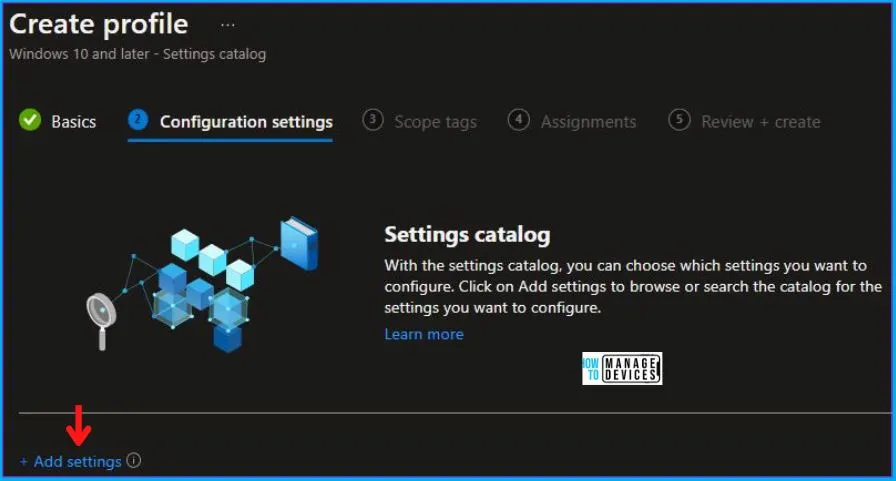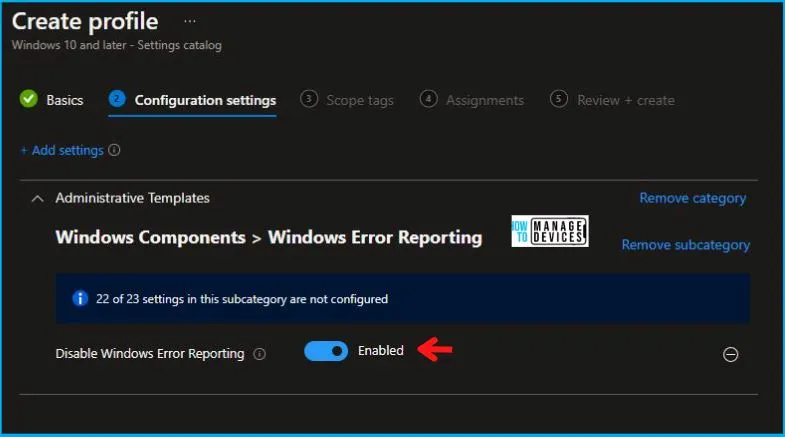This post aims to see and learn about the Windows Error Reporting Service Policy. We will Disable the Windows Error Reporting Service using Intune. To disable this Policy, we will use the Configuration Profiles from Intune.
In this setting, Windows Error Reporting is turned off, meaning that reports aren’t sent to Microsoft or to internal servers inside your organization when software unexpectedly stops working. Windows Error Reporting does not send any information about problems to Microsoft if you disable this policy setting.
In addition, solution information isn’t available in Security and Maintenance in Control Panel. The Turn off Windows Error Reporting policy setting in Computer Configuration/Administrative Templates/System/Internet Communication Management/Internet Communication settings takes precedence if you disable this policy setting or do not configure it.
If Turn off Windows Error Reporting is also either disabled or not configured, user settings in Control Panel for Windows Error Reporting are applied. In case you disable this policy setting, Windows Error Reporting will not send any problem information to Microsoft. Also, solution information is not available in Security and Maintenance in Control Panel.
Note – SyncML is required for the configuration of this ADMX-backed policy. Enabling a policy provides an example of SyncML format.
- Scan all downloaded files and attachments Policy Using Intune
- Do not Delete Temp Folders upon Exit Security Policy using Intune
Windows CSP Details DisableWindowsErrorReporting
Let’s go through Windows CSP Details for this Policy setting DisableWindowsErrorReporting. When software unexpectedly stops working or fails, this policy setting disables Windows Error Reporting, thus not sending reports to Microsoft or internal servers within your organization.
CSP URI – ./Device/Vendor/MSFT/Policy/Config/ErrorReporting/DisableWindowsErrorReporting

Windows Error Reporting Service Policy Using Intune
To set Windows Error Reporting Service Policy Using Intune, follow the steps stated below. You can also check out the video How to Disable Windows Error Reporting to check the same.
- Sign in to the Intune Admin Center portal https://intune.microsoft.com/.
- Select Devices > Windows > Configuration profiles > Create a profile.
In Create Profile, Select Windows 10 and later in Platform, and Select Profile Type as Settings catalog. Click on Create button.
| Platform | Profile Type |
|---|---|
| Windows 10 and later | Settings Catalog |

In the Basics tab pane, enter a name for the Policy as Windows Error Reporting Service Policy Using Intune. You can enter the Description for the Policy if you want, then select Next.

Now in Configuration settings, click Add Settings to browse or search the catalog for the settings you want to configure.

In the Settings Picker windows, if you search by the Windows Error keyword, you will see many categories, but you must select Administrative Templates\Windows Components\Windows Error Reporting.
When you select the option stated above, you will again see many settings, but you must select Disable Windows Error Reporting. After selecting your setting, click the cross mark at the right-hand corner, as shown below.

Now, in the Windows Components, Disable Windows Error Reporting, as shown below in the image.

You can assign a tag to filter the profile to specific IT groups using Scope tags. One can add scope tags (if required) and click Next to continue. Now in Assignments, in Included Groups, you need to click on Add Groups, choose Select Groups to include one or more groups, and click Next to continue.

In the Review + Create tab, you need to review your settings. After clicking on Create, your changes are saved, and the profile is assigned.

A notification will appear automatically if you see it in the top right-hand corner. One can easily see that the “Windows Error Reporting Service Policy” was created successfully. Also, if you check in the Configuration Profiles list, the Policy is visible there.
Your groups will receive your profile settings when the devices check in with the Intune service. The Policy applies to the device.
Intune Report for Windows Error Reporting Service Policy
From Intune Portal, you can view the Intune settings catalog profile report, which provides an overview of device configuration policies and deployment status for the Windows Error Reporting Service Policy using Intune.
One needs to select the Policy from the list of Configuration Profiles, To monitor the policy assignment, and, here it’s been checked the device and user check-in status. If you click View Report, additional details are displayed. Let’s now check the results of the Windows Error Reporting Service Policy using Intune.

Intune MDM Event Log
String policy has been applied to Windows 10 or 11 devices can be indicated by Intune event ID 813 or 814. In addition, you can view the exact value of the Policy that is being applied to those devices. For this Windows Error Reporting Service Policy using Intune, it’s a string and event ID 814.
To confirm this, you can check the Event log path – Applications and Services Logs – Microsoft – Windows – Devicemanagement-Enterprise-Diagnostics-Provider – Admin.
The log states the following – MDM PolicyManager: Set policy string, Policy: (DisableWindowsErrorReporting), Area: (ErrorReporting), EnrollmentID requesting merge: (4009A089-4FBA-482B-9D17-9E5A8428CB98), Current User: (Device), String: (<enabled/>), Enrollment Type: (0xD), Scope: (0x0).

You will get some important information like Area and Enrollment ID that will help you detect the registry path after you look in the event viewer to log above. Please refer to the below table for this information:
| Area | Policy | String Value | Scoped | Event ID |
|---|---|---|---|---|
| ErrorReporting | DisableWindowsErrorReporting | Enabled | Device | 814 |
Information from the above table of Windows Error Reporting Service Policy Using Intune can be used to REGEDIT.exe on a target computer to view the registry settings that store Windows CSP settings. These settings are located in the registry path.
- Computer\HKEY_LOCAL_MACHINE\SOFTWARE\Microsoft\PolicyManager\providers\4009A089-4FBA-482B-9D17-9E5A8428CB98\default\Device\ErrorReporting
When you navigate to the above path in the Registry Editor, you will find the registry key with the name ErrorReporting. Refer to the table and image below.
| Registry Name | Data |
|---|---|
| DisableWindowsErrorReporting | Enabled |

Author
Abhinav Rana is working as an SCCM Admin. He loves to help the community by sharing his knowledge. He is a B.Tech graduate in Information Technology.
